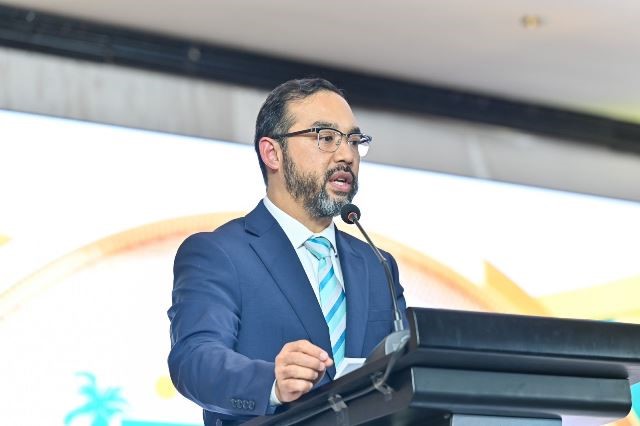GEORGETOWN, Guyana, (DPI) – NCB Capital Markets Chief Executive Officer (CEO) Angus Young wants the world to know that “GUYANA IS THE PLACE TO BE.” And if anyone was offended by thinking Young’s statement at the recent opening ceremony of the Jamaica Stock Exchange (JSE) 19th annual conference was immoderate, he immediately backed it up.
“Guyana is probably the fastest growing country in the western hemisphere having grown by an estimated 39 percent in 2023, (and it) has been estimated similar percentage growth for 2024.”
CEO Young continued: “And it is by far the fastest growing in the region. This places the country at the forefront of global conversations and its people are set to encounter with unprecedented changes for the good, the bad and the in-between,” he said.
The recently concluded conference was held under the theme, ‘The Drivers of Capital: From Concept to Growth’ and attracted more than 1,000 business leaders and aspirants from both private and public sectors regionally and internationally.
CEO Young contended that there are opportunities to assist in Guyana’s domestic capital market by leveraging the collective expertise and experience of other markets in the region such as Jamaica.
“This will be crucial to ensuring that every Guyanese citizen can participate in the world’s fastest-growing economy,” he counselled. “While traditional banking plays a vital role, it is not sufficient to harness the full spectrum of opportunities across various industries especially in the rapidly evolving landscape of Guyana.”
The Trinbagonian financier and businessman disclosed that Guyana’s model is drawing significant global interest, stressing that the energy sector will aid in creating vast and untold opportunities.
“In the region, traditional banks stipulate asset bank lenders relying on collateral as physical assets. However, the energy sector always requires specialised equipment posing a challenge for traditional banking. This is where the capital markets can play a pivotal role. The swift and expeditious development in Guyana presents tremendous opportunities for its people,” he stressed.
Guyana is located in the northeastern corner of South America. Its indigenous peoples, called the Amerindians (from American Indians) inhabited Guyana prior to European settlement, and their name for the land was Guiana (meaning land of many water), gave the country its name.
Contemporary Guyana reflects its British and Dutch colonial past and its reactions to that past. It is the only English-speaking country of South America. Since Guyana gained its independence in 1966, the country’s chief economic assets have been its natural resources, mainly its pristine rainforests, sugarcane plantations, rice fields, and bauxite and gold reserves. The recent massive raft of rich deepwater oil field discoveries in Guyana’s offshore Stabroek Block have potentially changed the country’s economic fortunes.
Some geographers classify Guyana as a part of the Caribbean region, which they deem to include the West Indies as well as Guyana, Belize, Suriname, and French Guiana on the South American mainland. The capital and chief port of Guyana is Georgetown.
The country’s populace is mainly of colonial origin, although the eight tribes of Amerindians are scattered throughout the forested interior. The more numerous coastal peoples are chiefly descendants of slaves from Africa and indentured workers from India, who were originally transported to work the coastal sugarcane plantations.
NCB Capital Market’s CEO Young reiterated his view that for Guyana to maximise these existing golden opportunities there are a few key imperatives.
“To seize this opportunity, access to the right scale and type of financing is imperative given the fast-paced commodity-based environment,” he declared. “By accessing capital markets the public gives exposure to the activities of direct investors in energy, energy-support and spinoff industries without direct involvement.”
The senior NCB executive noted that the movement of skilled labour regionally will further boost and enhance Guyana’s workforce.
“The recently announced ferry system between Guyana, Trinidad and Barbados should be seen as a catalyst for further activity for labour and physical resources.”
“Additionally, Guyana has signalled its openness to being a recipient of skilled labour in the region a situation that would boost and strengthen productivity of that market while threatening the already tight labour markets in other territories,” Young reasoned.





